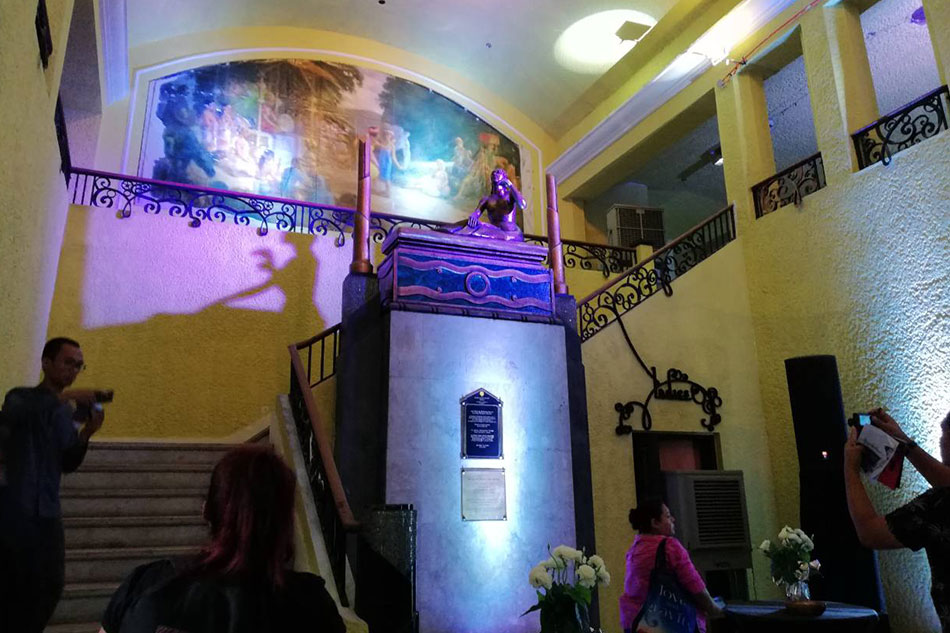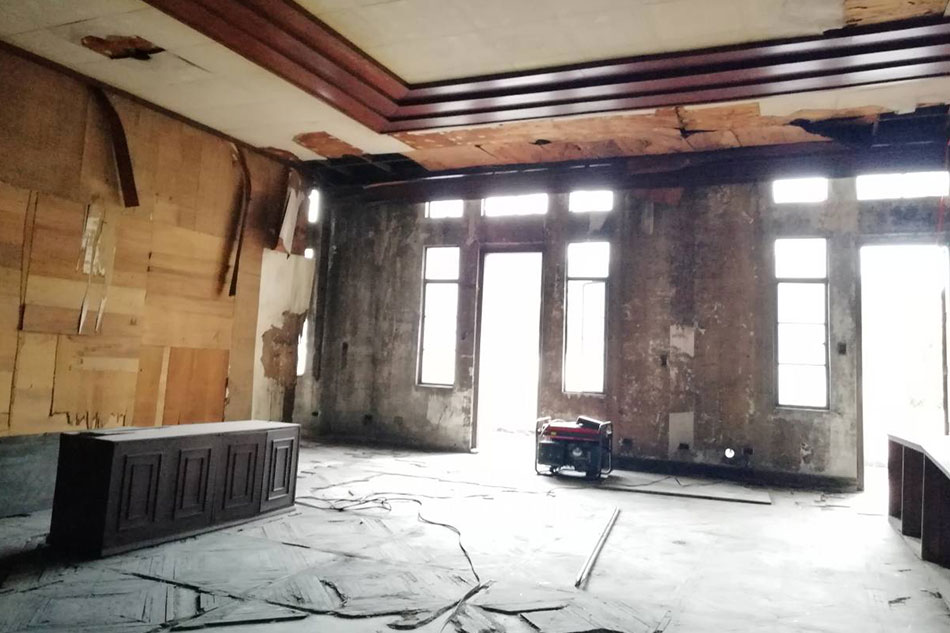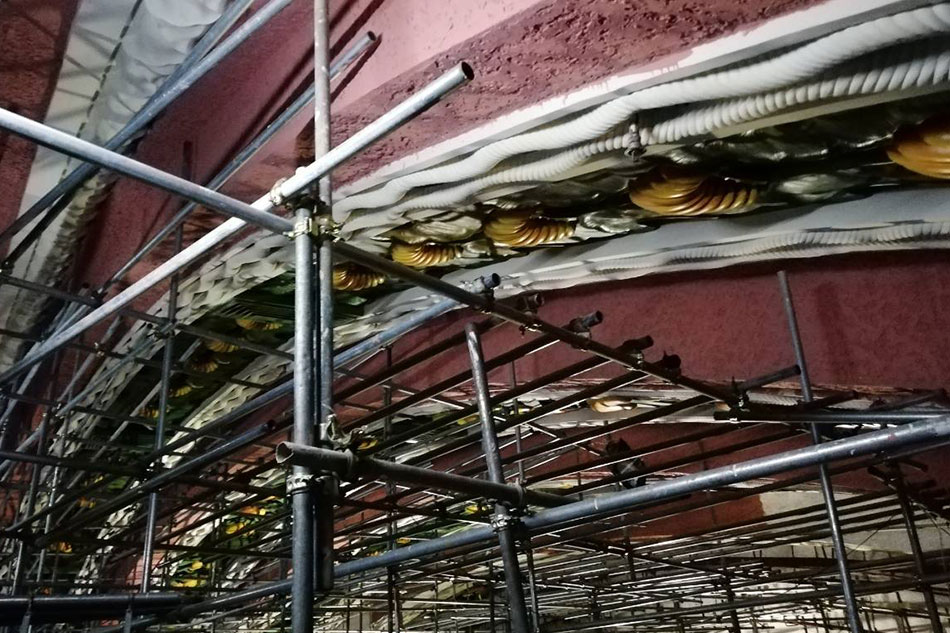LOOK: A peek into Metropolitan Theater's restoration | ABS-CBN

Welcome, Kapamilya! We use cookies to improve your browsing experience. Continuing to use this site means you agree to our use of cookies. Tell me more!
LOOK: A peek into Metropolitan Theater's restoration
LOOK: A peek into Metropolitan Theater's restoration
Kristina Casandra Tayam ,
ABS-CBN News
Published Dec 10, 2017 08:26 PM PHT
MANILA -- A fully restored Metropolitan Theater is targeted to open in 2020.
MANILA -- A fully restored Metropolitan Theater is targeted to open in 2020.
Heritage architect Gerard Lico, who is also a professor at the University of the Philippines (UP), made the statement Saturday when the Met, as the theater is fondly called, opened its doors to showcase the first phase of its ongoing restoration.
Heritage architect Gerard Lico, who is also a professor at the University of the Philippines (UP), made the statement Saturday when the Met, as the theater is fondly called, opened its doors to showcase the first phase of its ongoing restoration.
Lico is a consultant in the restoration of the Met.
Lico is a consultant in the restoration of the Met.
“I think this is a legacy that can be passed on to the next generation. That’s why kabataan ang ating target kasi sila 'yung magmamana nito,” Lico said in an exclusive interview with ABS-CBN News.
“I think this is a legacy that can be passed on to the next generation. That’s why kabataan ang ating target kasi sila 'yung magmamana nito,” Lico said in an exclusive interview with ABS-CBN News.
ADVERTISEMENT
While the first phase of the Met's restoration is already halfway done, restoring the main attractions of the theater like the lobby, auditorium, and ballroom hall, Lico estimated that the full restoration is still at 12-15 percent completion.
While the first phase of the Met's restoration is already halfway done, restoring the main attractions of the theater like the lobby, auditorium, and ballroom hall, Lico estimated that the full restoration is still at 12-15 percent completion.
The Met, which was inaugurated in 1931, is celebrating it 86th year Sunday. To mark the occasion, it held a special "Met Meets Met" event, which also included the Juan Arellano exhibit “Framing the Spectacle of Space,” on view at the Metropolitan Museum of Manila.
The Met, which was inaugurated in 1931, is celebrating it 86th year Sunday. To mark the occasion, it held a special "Met Meets Met" event, which also included the Juan Arellano exhibit “Framing the Spectacle of Space,” on view at the Metropolitan Museum of Manila.
Arellano is the Filipino architect who designed the Met, among other works like the National Museum and Manila Central Post Office building.
Arellano is the Filipino architect who designed the Met, among other works like the National Museum and Manila Central Post Office building.
During the event, the UP Dance Company and students from the UP College of Music Miguel Espino and Aljero Jimenez performed in the main lobby.
During the event, the UP Dance Company and students from the UP College of Music Miguel Espino and Aljero Jimenez performed in the main lobby.
Architectural designer for the NCCA Timothy Augustus Ong, who was also one of the head tour guides of Saturday's event, explained that the original blueprint of the theater dating from the 1930s will be followed throughout the restoration.
Architectural designer for the NCCA Timothy Augustus Ong, who was also one of the head tour guides of Saturday's event, explained that the original blueprint of the theater dating from the 1930s will be followed throughout the restoration.
ADVERTISEMENT
Among the original elements which will be restored are the popular “fruit salad” theater ceiling, the Adam and Eve sculptures in the lobby, and the Fernando Amorsolo’s paintings on both sides of the upper floor walls.
Among the original elements which will be restored are the popular “fruit salad” theater ceiling, the Adam and Eve sculptures in the lobby, and the Fernando Amorsolo’s paintings on both sides of the upper floor walls.
The ornaments and stained glass windows in the exteriors of Met are both in the process of restoration after they were damaged during World War II.
The ornaments and stained glass windows in the exteriors of Met are both in the process of restoration after they were damaged during World War II.
Some of the details and furniture that were not original to the theater will either be replaced or used for other functions.
Some of the details and furniture that were not original to the theater will either be replaced or used for other functions.
“Buildings are not static nor timeless. So they have to evolve with the time,” Lico said.
“Buildings are not static nor timeless. So they have to evolve with the time,” Lico said.
The goal of this project, Lico stressed, is the reinvention of Met, and that includes changing functions of other spaces in the auxiliary building.
The goal of this project, Lico stressed, is the reinvention of Met, and that includes changing functions of other spaces in the auxiliary building.
ADVERTISEMENT
“Kasi ang vision namin, it’s a cultural hub in Manila but distinct from CCP and other museum spaces. So, we have to reinvent the building to live again and to prolong its life. Kasi kapag hindi ginagamit 'yung building, mamamatay ito nang kusa. Kailangan re-instate mo 'yung significance ng building sa public, and to do that is [with] a program like this,” the rchitect said.
“Kasi ang vision namin, it’s a cultural hub in Manila but distinct from CCP and other museum spaces. So, we have to reinvent the building to live again and to prolong its life. Kasi kapag hindi ginagamit 'yung building, mamamatay ito nang kusa. Kailangan re-instate mo 'yung significance ng building sa public, and to do that is [with] a program like this,” the rchitect said.
Lico noted that looking at the building more closely, one would realize that it’s a manifestation of how the people behind the Met appropriated the language of Art Deco into the language of the Filipino; hence the mangoes, bananas, and bamboo ornaments.
Lico noted that looking at the building more closely, one would realize that it’s a manifestation of how the people behind the Met appropriated the language of Art Deco into the language of the Filipino; hence the mangoes, bananas, and bamboo ornaments.
“Kailangan natin ibalik sa collective imagination ng tao para magamit ito ulit. Kasi curious ang tao, ‘pag dumadaan dito, ano ba ‘tong building na nabubulok na ‘to? Wala silang alam kung anong significance nito. Kasi ang heritage hindi naman nakakain, pero it gives you identity not only as a people, but also as a nation,” he said.
“Kailangan natin ibalik sa collective imagination ng tao para magamit ito ulit. Kasi curious ang tao, ‘pag dumadaan dito, ano ba ‘tong building na nabubulok na ‘to? Wala silang alam kung anong significance nito. Kasi ang heritage hindi naman nakakain, pero it gives you identity not only as a people, but also as a nation,” he said.
ADVERTISEMENT
ADVERTISEMENT








